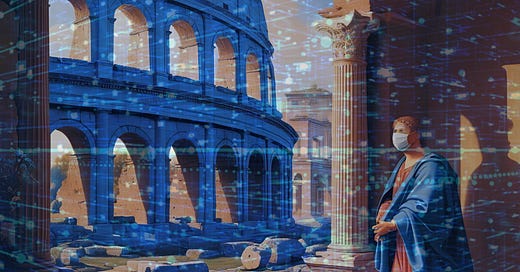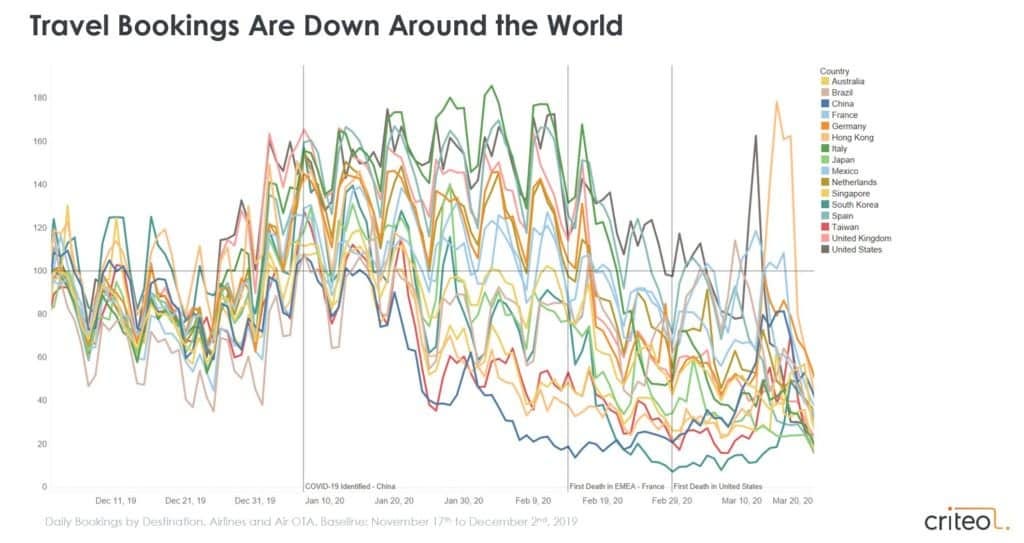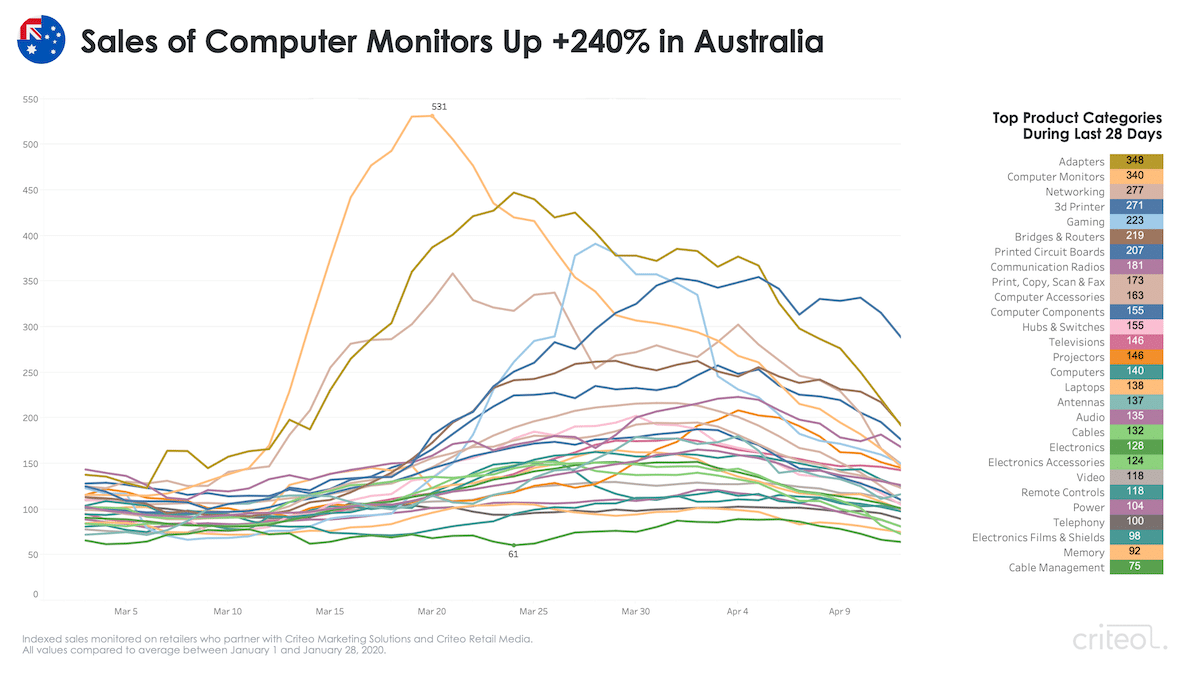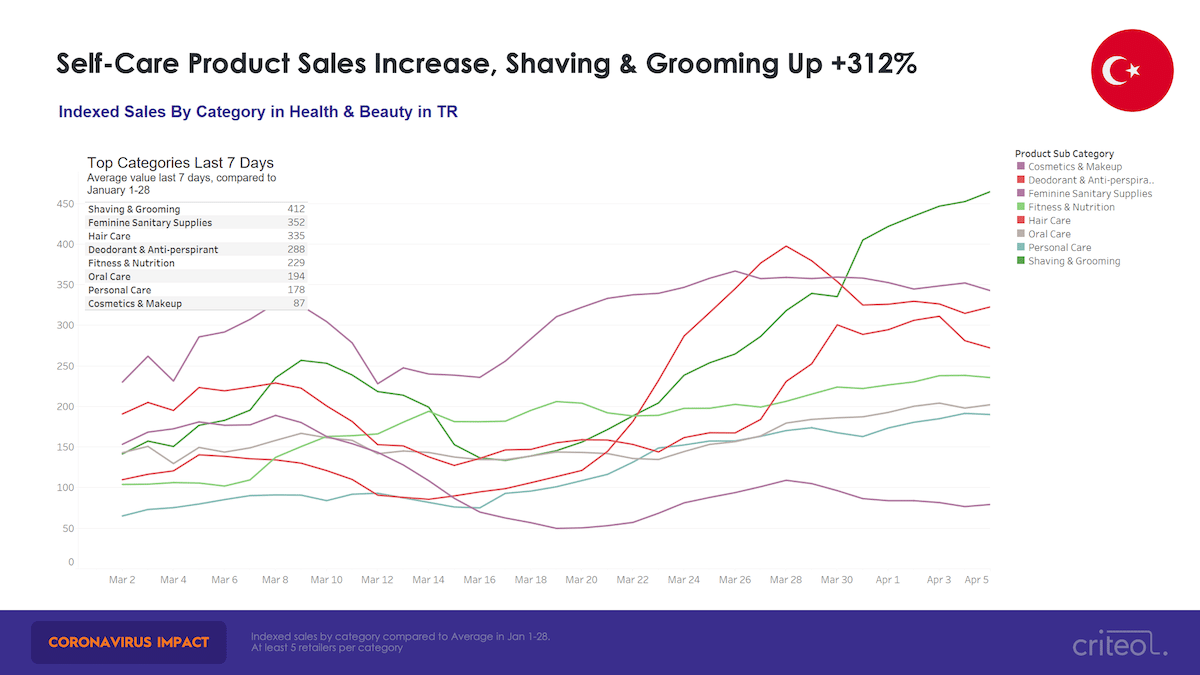The different accidents of life are not so changeable as the feelings of human nature.
- Mary Shelley, Frankenstein (1818)
Over the past month, I’ve had a case of claustrophobic nostalgia. From one side, everything is being squeezed dry by AI. From the other, the global order we’ve taken for granted has been shattered. The seismic changes reminded me of March 2020. So did the charts.
The tariff economy is based on tempers. The COVID economy was based on fear. Both form from feelings of doom. This is the cycle of apocalypse economics. And this time, just like last time, we’re looking at data points the same way our ancestors looked at stars for salvation. Or what or who to sacrifice next. But the data behind apocalypse economics is not just numbers. It’s very much the story of how people change their patterns and priorities. During COVID, I saw that story firsthand. And what we keep buying at the end of the world.
In 2020, I was the head of global content at Criteo, a global ad-tech company with 3,000 employees. The core product was a world-class algorithm that processed some billion transactions a year, then learned and predicted who, when, where, and how people all over the world would buy based on that data. Or, if you want to be crude about it, we chased people around the internet with ads.
When the world shut down in 2020, my team, built reports across dozens of countries directly from our database. In March 2020, the South Korea team needed a strategy first. Then Japan. Italy. Spain. Then the world. Here’s who we are - measured by what we buy - in an apocalypse economy.
1. We Stop Traveling and Stand Still.
Lockdowns destroyed the travel industry first. The demand for airlines, hotels, cruises, and tourist destinations collapsed overnight. Traveling anywhere before the vaccine was seen, worldwide, as the worst thing anyone could do. And potentially deadly.
The data that we saw was the data of hard, painful decisions to cancel countless dreams in the name of safety. In an apocalypse, everyone decided to stand still at once. To keep themselves and others safe.
2. We Turn Home into Work.
The Puritans would be proud: even as a plague ravaged the world as we knew it, we bought new screens to see the world and keep the machine running - from Australia to Asia, Europe to America. Australia, one of the earliest countries to be exposed to COVID-19 outside of China, saw monitor sales spike by 240%.
Or did we just want to keep working? In the UK, office chair sales went up by 198% and desks rose by almost 2.5X in just a few weeks.
The sudden change in buying behavior showed a global agreement: we would still work. Feeling useful, as it turns out, is a survival instinct. During COVID, we prioritized the tools that helped us do something useful.
3. We Still Need to Connect to People.
Before Zoom was just another annoying word for “meeting,” it was a link to our humanity. Zoom gave us a window to see and hear the people who were most important in our lives, no matter where they were. Whatever else was happening, we would not stop talking to family and friends. No matter what. That’s why Zoom’s stock went from $70 a share in January 2020 to $568 by October 2020. Today, it’s back at $71.
In France, Criteo data found that webcam sales went up by almost 20X. If they wanted to look somewhere other than a screen, the French bought binoculars. Sales went up by 1.5X as lockdowns were announced.
3. We Want to Be Comfortable.
Going outside in pajamas? Stylish pajamas? Loungewear for the masses?
Work meetings in unembarrasing sweatpants?
Unimagined and uninspired until COVID-19.
In lockdown, we discovered soft fabrics that made us look classy. Even if we felt lazy or exhausted with depression. In Australia, sleepwear and loungewear sales doubled as soon as the government told people to stay inside. We still demand comfort. Even if there’s no tomorrow.
4. We Want to Stay Beautiful.
Barber shops and beauty salons closed during COVID-19.
But that didn’t put a stop to rigorous self-care regimens around the globe. In Turkey, shaving and grooming sales tripled as people stayed conditioned and hairless, deodorized and moisturized from the comfort of their own home.
Apocalypse or not, we still wanted to look good for it.
5. We Don’t Leave Our Pets Behind.
A cat has absolute emotional honesty: human beings, for one reason or another, may hide their feelings, but a cat does not.
-Ernest Hemingway
During a plague, you might think that people would put themselves first. But Criteo data showed that people don’t hesitate to make sure that their furry family members got what they needed. In the US, pet products spiked by 400% as people built their bunkers for the unknown and made sure their pets stayed healthy and well-fed.
This is hopeful data, a statement on humanity’s natural selflessness and sacrifice for the annoying animal companions we’ve decided to bring into our family. We don’t think twice about it.
5. We Need to Move, Even if We’re Stuck.
COVID-19 saw record-breaking sales of exercise equipment. Peloton bikes arrived to our homes in an avalanche of boxes and parts and masked delivery teams. Today, many live on as fairly serviceable drying racks. I still remember the empty glare of my Peleton instructor as they yelled to the camera in an empty room to “give me all you got” before going out to beat pots and pans from my balcony by the hospital by the UN.
When gyms shut down and fitness classes closed, people found new ways to move for the sake of their mind and body. In Germany, the demand for exercise bands went up by more than 700% as millions of Germans stood in place and bound themselves by rubber loops and pulled up and down.
Putting the People Back in the Data
Human sympathy has its limits, and we were content to let all their tragic arguments fade with the city lights behind.
-F. Scott Fitzgerald
Without a story, data is a system instead of a spirit. Systems are easier for aggrieved STEM majors to optimize without remorse and without bothering with any annoying humanity that might slow things down with messy, hard-to-measure emotion.
But from where I sat at Criteo during the apocalypse economics of 2020, I saw a story of how fast people can change their priorities when they have no choice. The people that just believed in the numbers are the same people who thought we would all never visit a retail store or gym again. That’s what you get if you’re just looking at data points instead of the people behind the data.
This year is going to be a new era of apocalypse economics. Whether we like it or not, the economy is being remade before our eyes with the same speed - and contagion - as COVID. I wouldn’t be surprised to see similar purchase trends as people drop what isn’t important and focus on buying what is important. This time, at least, we’ll be able to go outside. And maybe with all the emphasis on cutting waste and fraud and automating everything that can be automated, people will be forced back into an outdoor economy this time. As we saw last time during COVID, even an apocalypse can’t stop us from building a world for ourselves without thinking twice about how long it will last.
Feeling nostalgic about apocalypse economics? Read Destination Tragedy for a recap.














Great observations! A whole new way of looking at the end of the world. Put a smile on my face -
we will survive!
Like Connie, I was taken by your conclusion, which went beyond easy doom-&-gloomerism. It was a good reminder that destruction and restoration live in creative tension with each other, and that there are seeds in the rubble 💪🤝
Thanks for animating these data sets with your own eye - and for a job well done in bringing your work experiences into the metaphysical clearinghouse that is Litverse 🙌